
By Catherine Cashmore, a market analyst, journalist, and policy thinker, with extensive industry experience in all aspects relating to property. Follow Catherine on Twitter or via her Blog.
“Too many workers live too far away to fulfil our cities’ economic potential” – is the conclusion of a recently published study by the Grattan institute.
The report maps the dollar value of goods and services produced by workers within a particular area of Australia’s biggest cities. Demonstrating a disproportionate 80% is created on just 0.2% of the nation’s land mass.
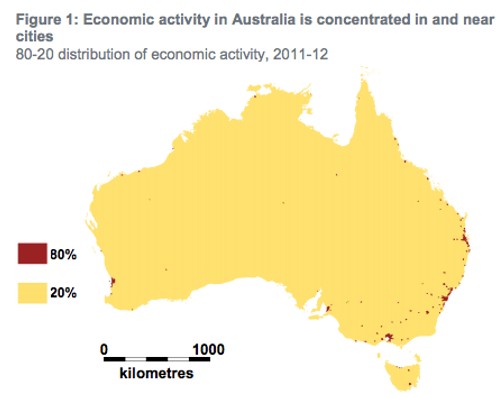
It mirrors findings highlighted in a recent speech by Luci Ellis – Head of Financial Stability at the RBA, who collected the addresses of people’s work places from the 2011 Census, to construct a picture that is particularly striking if directly contrasted with where employees actually live.
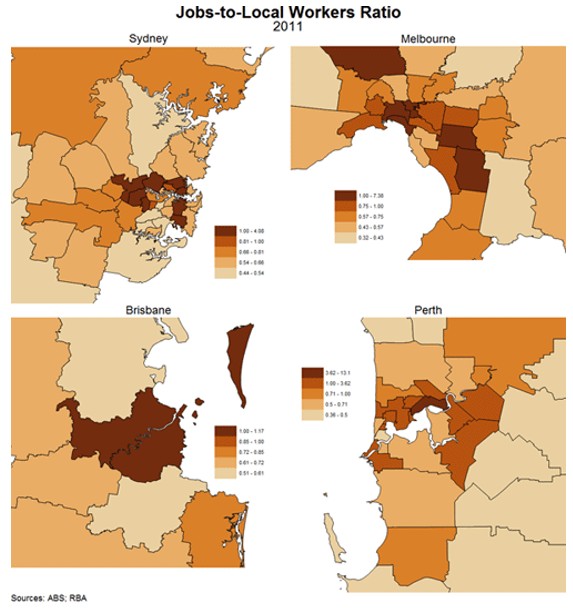
“Inner areas have become even greater job magnets in recent years; some middle and outer areas added people, but not so many jobs, so their job-to-worker ratios actually declined.”
Places with ratios well above 1 are employment centres. They pull in commuters across the city even from outside its borders.
While the very pale fringe areas, attracting the largest population growth due to pressures of affordability, are the ‘commuter districts,’ dormitory suburbs, where jobs and community infrastructure have failed to follow through.
The picture is one of increased social polarisation – fringe localities; tend to face higher crime rates, elevated levels of unemployment, along with reports of depression and mental illness, Poor supply policy and delays in zoning pockets within the urban boundaries for residential development, means a typical house and land package on a compact 450sqm site, transacts for no less than $400,000.
Instead of a sensible system of bond financing, where residents pay back proportionally over a lengthy period of time, or a broad based land value tax to replace other taxes as advocated in the Henry Tax Review, funds for the provision of essential infrastructure are loaded onto the upfront cost of housing and promptly passed to the buyer.
Yet Councils can wait years for the finances to arrive. The funds are only payable upon subdivision and with no control over the development or release of newly zoned land; buyers can often pay for services they may never receive.
The Grattan report is subtitled “Cities as Engines of Prosperity” and charts Australia’s evolution from a country that “made things,” into one that is now reliant on centrally clustered “knowledge-intensive and specialised services.”
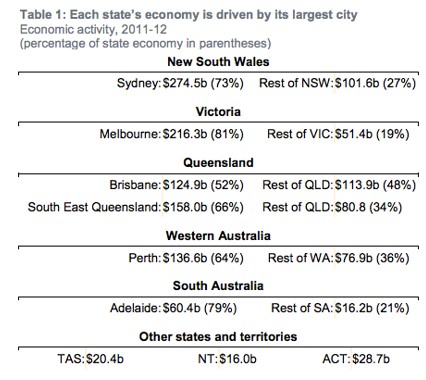
Together, the cities above account for 15% of Australia’s economic activity, but despite declining job-to-worker ratios in the outer suburbs, along with increases in the price-to-distance trade off for home buyers, only 8% of Australia’s employed population actually work in the central hubs of each major capital.
In Melbourne for example, over 50% of jobs are located more than 13km from the inner core, with fewer that 20% of jobs in the CBD itself.
These are not high paying jobs however, which leads the authors to imply we need to move closer in and –“Minimise barriers to highly productive activity in CBDs and inner city areas”.
They suggest this would provide industries with a “wider range of potential workers to choose from”:
“Australia’s cities are the backbone of our economy, with CBDs and inner city areas critically important to the nation’s prosperity….The more highly skilled and specialised a job, the greater the need to find the best person to fill it.”
Knowledge based and specialised services cover a diverse area, including industries such as, finance, insurance, real estate, and business services, as well as cultural, media, communication, and education facilities for example.
They are gaining predominance across the globe, due to a technological boom that is powering us forward in an expansion not unlike the industrial revolution.
3-D printing is lowering the cost and logistics of production. Advances in the research of solar and renewable energy have paved the way for homeowners to store electricity overnight and possibly disconnect from the grid completely.
Companies such as ‘Uber’ and ‘Lyft’ have created innovative ‘apps’ to provide cheaper transport options for consumers and ironically, changes in the way we interact and communicate have allowed people and jobs to disperse over a broader footprint and successfully collaborate across international borders.
However, this is not where Australia excels.
Moves to take advantage of the innovation revolution have been continually hampered by Government intervention, winding back tariffs and scaling down their 2020 Renewable Energy Target, acting to protect the cartel of the Taxi industry’s ‘licensing’ monopoly, and cutting funding to organisations such as the CSIRO.
No – the predominant sector that yields the most “knowledge intensive” gains in Australia comes from the FIRE industry (finance, insurance, and real estate)– which has its infrastructure webbed like a parasite on the back of the great Australian housing boom.
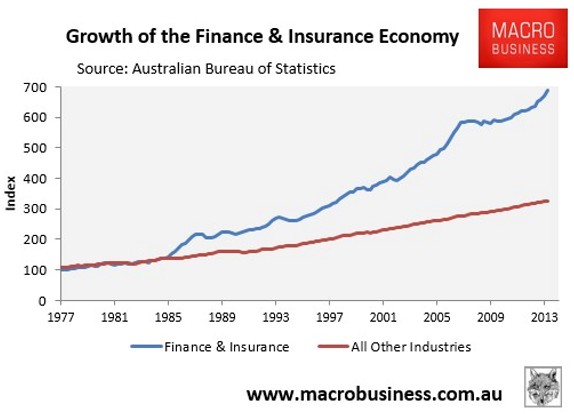
At a global banking conference in 2013, the question was asked ‘Why the hell are Australian Banks performing so well!?’ – it was in response to a chart showing a decade rise in market capitalisation on the global banking index, from 2% to 14%.
The answer was obvious; the banking sector makes its money by creating debt – mostly mortgage debt and our highly leveraged ‘too big to fail four’ are the world’s most heavily exposed to residential and commercial real estate, capturing 88% of the mortgage market alone.
To be clear, the FIRE Economy is not a value adding economy; it profits by extracting economic rent from the debt on rising land values, impeding areas of productive enterprise, and trading the interest in a multi trillion-dollar derivatives market to advantage those sitting at the top of the financial pyramid.
To survive, the FIRE sector must sell the illusion that the economy and its participants can achieve economic prosperity through speculation on rising property values.
This has been assisted by tax, housing, and monetary policy, resulting in Australian’s holding some of the highest levels of private debt in the developed world.
Tax withholdings or exemptions given to land holders for example, result in an increase of unearned monetary gains (economic rent) available to be capitalised at the current interest rate into the upfront cost of land.
This was aptly demonstrated in a recent release by Moodys’ Analytics, estimating how the tax policy of negative gearing, has acted to inflate Australian house prices by no small degree.
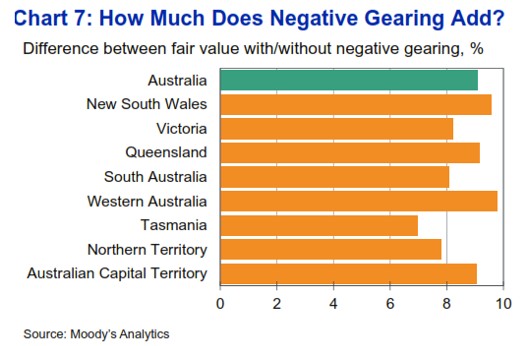
Supply policy has further assisted.
Inelastic responses to market conditions have allowed professional land-bankers to squat on sites at low cost and secure windfall gains when the sites are later rezoned for residential development.
Allowing the uplift of land values to capitalise year upon year into the cost of housing, may be gift-wrapped with corporate spin, to suggest it somehow benefits the community, when a cursory analysis reveals the exact opposite to be true.
It raises the cost of living for every single household, increasing welfare costs, and leaving less to invest in sustainable industries that contribute to the county’s real ‘value adding’ economy.
As demonstrated by the British economist and historian Fred Harrison in his book “The Great Tax Clawback Scam.”
The pull of the centralised core, where property values and wages are highest, results in decades of progressive taxes on every worker in the state being clawed back by a few, as inner city land values benefit from higher incomes, increased demand and improvements to social infrastructure and transport arterials to do precisely as the Grattan review suggests – and keep us locked and reliant on a small pocket of land for our economic gains.
The benefits for homeowners can obviously be substantial.
It brings with it the theory of urban consolation – reduce sprawl and force residents into apartments, however doing so can have the adverse effect of increasing sprawl, as lesser industries ‘hop’ the middle ring, in search of cheaper options, and their employees move out further still.
If we were living in ancient Rome where walking was the general mode of transport, you could understand the need to stay centrally located, however we are not.
We’re in an age of mobility where global research is being poured into innovative modes of transportation such as solar roads and electric cars.
If a buyer is able to travel to the supermarket, park and any other amenity on the priority list within a 30 or 40-minute period, the distance from the CBD is not an imposing factor.
The decider is the time it takes to drop the kids off to school in one direction, and travel to work in the other.
Since the 1970’s, successive governments have poured millions into incentives to try and decentralise and boost regional localities. However, all attempts have failed, because the both the funding and supply mechanisms are flawed.
Decentralisation requires affordable land for both business and buyer, which is not unduly inflated due to policies that promote speculation, as well as growth enhancing infrastructure and flexible supply policy that responds in a timely manner to homebuyer (not speculator) demand.
The Henry Tax review was not slow to point this out, when it suggested slowly phasing out a vast array of ‘bad taxes’ (deadweight taxes) that impede productivity and reduce mobility (stamp duty, payroll, insurance, vehicle registration, and so forth, as well as phasing out those that ‘reward’ speculation) and instead, collecting more of the economic rent from a broad based tax on the unimproved value of land and natural resources.
According to research undertaken by Paul D Egan and Philip Soos, in 2013 we lost a staggering $73 billion of output stemming from deadweight losses of taxation, yet, economic rents, which exhibit no deadweight loss, are a significant component of the Australian economy, comprising 23.6% of GDP.
When extensive research was carried out by ‘Prosper Australia’ on the “Total Resource Rents Of Australia,” it was recognised that almost half of all government revenues could be delivered by channelling the property boom to more productive purposes.
However, while the example is useful for policy reform – even a small shift in the tax base to provide a steady source of revenue in lieu of stamp duty, would assist in reducing speculation and aiding mobility (As economist Leith van Onselen has repeatedly demonstrated.)
With less reliance on income tax, land value taxation would also act to shift economic power back to state and local government, thereby giving them more control over spending and in a very minimal way, it may also act as a natural countercyclical force.
For example, when land values depress due to a drop in consumer confidence, buyers would have less tax to pay, and therefore more discretionary income to spend into other areas of the economy – Government would reap any fall in revenue back when the reverse is the case. (Albeit, there are many variables that could affect this and other points to discuss.)
Historically, the capture of economic rent (through land tax and to some extent ‘betterment’ taxes) financed some of the most remarkable infrastructure we have. The Sydney Harbour Bridge being a case in point.
It was acknowledged at the time, that residents on the north shore would benefit significantly from an increase in their property values as a result of this essential piece of infrastructure. Therefore, a framework was set in place to capture a proportion of the uplift – approximately one third – to assist with funding.
This was in no way detrimental to the property owners.
The increased advantage of economic activity coupled with the rise in prices resulting from the enterprise, more than compensated. A win-win if you like – and readily accepted by the public as ‘fair.’
Over time, changes in the way both state and federal government collect tax moved focus away from land values onto productivity, effectively placing a fine on labour and doing a good job of keeping us asset rich and income poor.
It’s great for the haves – but not the ‘have-nots’ (our growing pool of tenants.)
A similar concept is recognised by owners of apartments.
When buyers purchase a unit, they expect to pay a yearly corporation fee for maintenance and improvement of community services.
In doing so, it reduces the up front cost consumers are willing to pay as they configure the fee into their budget, yet it is also recognised as an investment, as the benefits and any subsequent improvements help attract future purchasers.
A broad based land value tax is essentially no different.
In markets that have similar policies – a change in the tax mix, with higher taxation on land in lieu of those on productivity in order to fund related infrastructure, coupled with good supply policy, enables a process of decentralisation and increased affordability to follow through.
Both reforms work hand in hand.
The prosperous economy of Texas in the USA is a good example of this.
Since June 2009, about 48% of all jobs created in America have been in the state.
It has booming population growth, high levels of disposable income, low house prices and has been termed “The Texas Miracle.”
This is because with no income tax employees get to keep more of their earnings while higher property taxes used to fund community infrastructure and stem speculative inflation, along with good supply policy, help create a truly decentralised city, with only 7% of jobs located ‘downtown.’
Importantly, when the locational value of land is allowed to capitalise into the price, there is every reason for homeowners and investors to object to an increase in supply.
When this gain is partially taxed away, offset by higher earnings due to lower income tax (as it is the case in Texas,) vested interests diminish and neighbourhood development may even be encouraged in response to population growth as it spreads the burden of taxation and acts to reduce the level payable for the individual owner.
We do not have to mirror another country’s policies, but it does prove the ability to create a system that provides a fairer regime for the funding of infrastructure, stops runaway land price gains as well as assisting households and commerce to move outwards.
However, in an economy that is dominated by the financial sector, and reports such as the latest Grattan review celebrating Australia’s city-centric culture, efforts to decentralise and produce a fairer system for all Australian’s are deteriorating in favour of policies that are there to benefit the rent-seeker, at the expense of the labourer.

